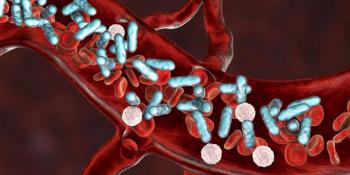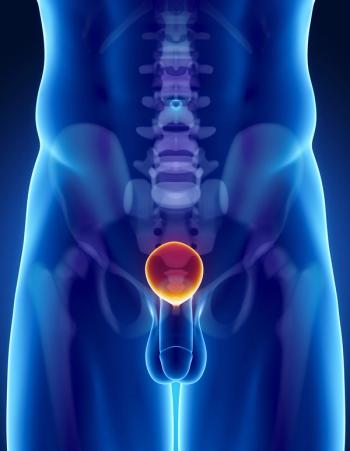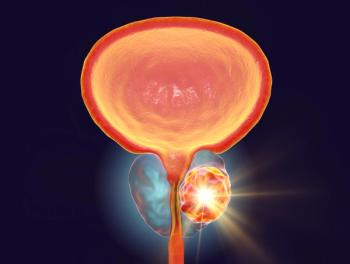
Novel Agent Meets End Points in COMPETE Trial for GEP-NETs
ITM-11 showed superior PFS and ORR compared with everolimus in patients with gastroenteropancreatic neuroendocrine tumors.
177-Lu-edotretide (ITM-11) vs everolimus (Afinitor) met the primary and secondary end points for patients with gastroenteropancreatic neuroendocrine tumors (GEP-NETs) according to the final analysis from the phase 3 COMPETE trial (NCT03049189) presented at the
The primary end point was median progression-free survival (mPFS), and was significantly longer in patients who received ITM-11 compared with those who received everolimus. The secondary end point of the trial was overall survival (OS), which was also identified to be higher in patients who were given ITM-11 vs everolimus.2
There was a total of 207 patients in the ITM-11 group and 102 patients in the everolimus group, respectively. The median ages of both groups were 65 (ITM-11), and 61 (everolimus). The majority of patients in both groups were male (531.1% vs 56.9%). The majority of patients had grade 2, non-functional GEP-NETs (83.2% vs 86.4%) and had received prior therapy (85.5% vs 83.3%).1,2
What Were the Results of the COMPETE Trial?
COMPETE met its primary end point of mPFS, which proved to be significantly longer in patients treated with ITM-11 vs everolimus. The central assessment had a mPFS of 23.9 months (95% CI, 18.7-30.0) vs 14.1 months (95% CI, 9.2-20.9; HR, 0.67; 95% CI, 0.48–0.95; P = .022). The local assessment was 24.1 months (95% CI, 21.2-26.7) vs 17.6 months (95% CI, 12.2-21.0; HR, 0.66; 95% CI, 0.48-0.91; P =.010).2
In the subgroup analysis of PFS by tumor origin, mPFS was found to be numerically longer for GE-NETs and P-NETs in the ITM-11 arm. For GE-NETs, the mPFS was 23.9 months (14.0-not evaluable [NE]) vs 12.0 months (95% CI, 8.8-23.7; HR, 0.64; 95% CI, 0.38- 1.08; P = .090). For P-NETs, the mPFS was 24.5 months (18.4-30.0) vs 14.7 months (95% CI, 8.5-NE; HR, 0.70; 95% CI, 0.45-1.09; P = .114).2
It was also identified that mPFS was numerically longer in grade 1 and significantly longer in grade 2 tumors in the ITM-11 arm. Grade 1 had a mPFS of 30.0 months (95% CI, 9.5-NE) vs 23.7 months(95% CI, 12.0-NE; HR, 0.89; 95% CI, 0.42-1.8; P =.753), and grade 2 had a mPFS of 21.7 months (95% CI, 18.6-29.9) vs 9.2 months (95% CI, 8.5-18.1; HR, 0.55l; 95% CI, 0.37-0.82; P =.003).2
PFS was also assessed by prior therapy; it was identified that mPFS was numerically longer in the first line and significantly longer in the second line in the ITM-11 arm. First line data showed the mPFS was not reached in the ITM-11 arm vs 18.1 months (95% CI, 4.4-NE) in the everolimus arm (HR, 0.60; 95% CI, 0.25-1.45; P = .249), and second line data showed the mPFS of 23.9 months (95% CI, 18.2-29.9) vs 14.1 months (95% CI, 9.2-21.0; HR, 0.68; 95% CI, 0.47-0.98; P=.039).2
Overall response rates (ORR), one of the secondary end points of the trial, were found to be significantly higher in the ITM-11 arm. Central assessment showed an ORR of 21.9% vs 4.2% (P<.0001) between both arm, with complete responses (CR) being 1.9% vs 0.0%, partial response (PR) of 19.3% vs 3.9%, stable disease of 59.4% vs 72.5%, progressive disease of 16.4% vs 16.7%, and no post-baseline CT data available or missing in 2.9% vs 6.9%. For local assessment, the ORR was 30.5% vs 8.4% (P<.0001) with a CR of 0.0% vs 1.0%, PR of 30.0% vs 6.9%, stable disease of 58.9% vs 72.5%, progressive disease of 9.2% vs 12.7%, and no post-baseline CT data available or missing in 1.9% vs 6.9% .2
What Adverse Events Were Reported?
Adverse events (AEs) related to the drug study were experienced by 82% of patients ITM-11 group, and 97% of patients in the everolimus group. The most common AEs reported were nausea (30% vs 10.1%), diarrhea (14.3% vs 35.4%), asthenia (25.3% vs 31.3%), and fatigue (15.7% vs 15.2%). These AEs were expected based on the known safety profile of ITM-11.2
AEs leading to premature study discontinuation occurred in 1.8% vs 15.2% of patients between the groups, respectively. Dose modification or discontinuation occurred in 3.7% vs 52.5% of patients among both groups, and the number of patients with delayed study drug administration due to toxicity was 0.9% in the ITM-11 group and not available in the everolimus group.2
Dosimetry data showed targeted tumor uptake with low exposure to healthy organs, with normal organ absorbed doses well below safety thresholds.
What Were the Patient Criteria?
Patient inclusion criteria included being 18 or older; having well-differentiated, non-functional GE-NET or functional/non-functional P-NET; grade 1/2 unresectable or metastatic, progressive, SSRT-positive+ disease; or being treatment-naive to first-line therapies or progressing, or progressing under prior second-line therapies.1,2
Morphologic imaging was conducted in 3-month intervals. The PFS follow-up was done every 3 months after the first 30 days. Long-term follow-up was done every 6 months.
“With these data combining extensive dosimetry information from more than 200 patients included in a prospective trial, ITM is laying the groundwork for improved therapeutic decision-making by providing important insights into tumor uptake and treatment variability,” Emmanuel Deshayes, MD, PhD, professor in biophysics and nuclear medicine at the Montpellier Cancer Institute in France, said in a news release.2 “It may offer clinically meaningful implications for optimizing individualized patient management.”
Dosimetry data from COMPETE shaped the design of ITM’s phase 3 COMPOSE (NCT04919226)4 trial, with ITM-11 in well-differentiated, aggressive grade 2 or grade 3 SSTR-positive+ GEP-NET tumors, as well as the upcoming phase 1 pediatric KinLET (NCT06441331) study in SSTR-positive+ tumors.
Disclosures: Capdevila noted grants and/or research support from Advanced Accelerator Applications, AstraZeneca, Amgen, Bayer, Eisai, Gilead, ITM, Novartis, Pfizer, and Roche; participation as a speaker, consultant, or advisor for Advanced Acclerator Applications, Advanz Pharma, Amgen, Bayer, Eisai, Esteve, Exelixis, Hutchmed, Ipsen, ITM, Lilly, Merck Serono, Novartis, Pfizer, Roche, and Sanofi; position as advisory board member for Amgen, Bayer, Eisai, Esteve, Exelixis, Ipsen, ITM, Lilly, Novartis, and Roche; and a leadership role and chair position for the Spanish Task Force for Neuroendocrine and Endocrine Tumours Group (GETNE).
References
- 1.Capdevilla J, Amthauer H, Ansquer C, et al. Efficacy, safety and subgroup analysis of 177Lu-edotreotide vs everolimus in patients with grade 1 or grade 2 GEP-NETs: Phase 3 COMPETE trial. Presented at: 2025 ESMO Congress; October 17-20, 2025; Berlin, Germany. Abstract 1706O
- 2. ITM presents dosimetry data from phase 3 COMPETE trial supporting favorable efficacy and safety profile with n.c.a. 177Lu-edotreotide (ITM-11) in patients with gastroenteropancreatic neuroendocrine tumors at EANM 2025 Annual Congress. News release. ITM. October 8, 2025. Accessed October 18, 2025. https://tinyurl.com/3nuscs4m
- 3. Lutetium 177Lu-Edotreotide versus best standard of care in well-differentiated aggressive grade-2 and grade-3 gastroenteropancreatic neuroendocrine tumors (GEP-NETs) – COMPOSE (COMPOSE). ClinicalTrials.gov. Updated September 10, 2025. Accessed October 18, 2025. https://www.clinicaltrials.gov/study/NCT04919226
- 4. Phase I trial to determine the dose and evaluate the PK and safety of lutetium Lu 177 edotreotide therapy in pediatric participants with SSTR-positive tumors (KinLET). ClinicalTrials.gov. Updated September 19, 2025. Accessed October 18, 2025. https://www.clinicaltrials.gov/study/NCT06441331
Newsletter
Stay up to date on recent advances in the multidisciplinary approach to cancer.


















































































